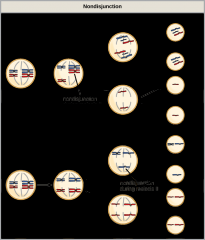![]()
![]()
![]()
Use LEFT and RIGHT arrow keys to navigate between flashcards;
Use UP and DOWN arrow keys to flip the card;
H to show hint;
A reads text to speech;
9 Cards in this Set
- Front
- Back
|
what are the benefits of identifying a disease gene? |
Genetic testing, all newborns in UK tested for five genetic disorders,
Allows development of new treatments ( drugs, gene therapy)
knowledge of familial (inherited diseases) can provide insights into non-familial versions of the diesase. |
|
|
what are the stages involved in getting from the disease to the gene responsible? |
1) Pedigree analysis: occurence within families to determine what type of mutation,
2)Linkage analysis: look for evidence between linkage between disease gene and markers
Allowing to map the disease gene as closely as possible
3)Identifying disease gene: select candidate genes in the region of the chromosome identifies in linkage analysis,
look for mutations within these genes |
|
|
In a pedigree , how are males and females represented? |
Females circles
males squares |
|
|
Why are pedigree analysis' to be taken lightly? |
1)penetrance and Expressivity
Not all individuals with disease mutation show disease phenotype (incomplete penetrance),
or different individuals show phenotype to differing extents (variable expressivity)
Incomplete penetrance and variable expressivity often associated with dominant inheritance
Penetrance can be age related
2)Genetic Heterogeneity
mutations in different genes can cause same disease
*also have to consider non-paternity events, wrong father |
|
|
what is Aneuploidy? |
type of chromosome abnormality, where chromosome number is abnormal, but does not involve loss or gain of complete set ( not chromosome duplication). |
|
|
types of Aneuploidy? |
nullisomy/ nullisomic: loss of homologous pair (2n-2)
monosomy / monosomic: loss of single chromosome (2n-1)
trisomy / trisomic: one extra chromosome (2n+1)
tetrasomy / tetrasomic : extra pair (2n+2) |
|
|
incidence of chromosome abnormality |
7 in1000 live births |
|
|
How and when do aneuploid gametes arise? |

during meiosis
disjuntion is where homologous chromosomes ( chromatids) are seperated to opposite poles
non-disjuntion: is where the chromatids go to one pole and not the other
non-disjuntion can occur in first or second meiotic division |
|
|
Why does incidence of trisomy ( that can cause down syndrome) 2n+1, increase with the age of the mothers? |
human oocytes are paused in meiosis 1 for decades,
arrested at late prophase 1, paired replicated chromsomes
arrested developemnt occurs before birth, and restarted when needed for menstrual cycle
problems with pairing of homologous chromsomes increases with age, increased probability of breakdown |

